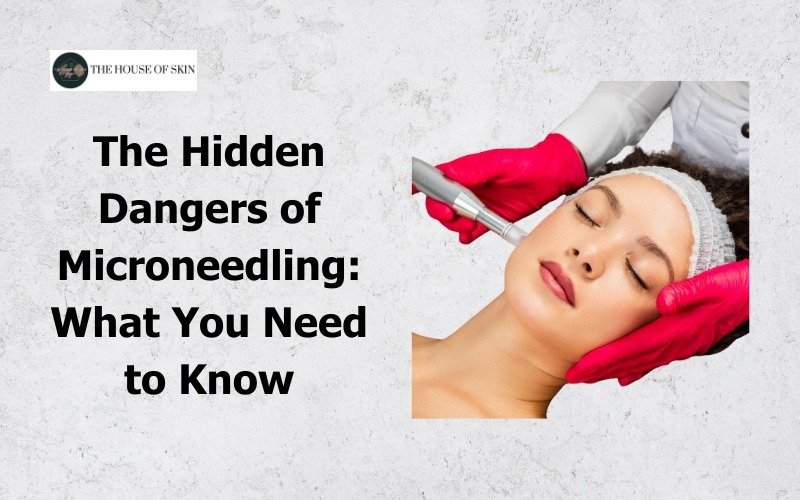Introduction
Microneedling has gained popularity as a minimally invasive cosmetic procedure that promises to rejuvenate the skin, reduce scars, and improve overall skin texture. However, as with any medical treatment, it’s crucial to understand the potential risks and side effects associated with microneedling. This comprehensive guide delves into the hidden dangers of microneedling, providing you with research-backed information to make an informed decision about this skin treatment.
What is Microneedling?
Microneedling, also known as collagen induction therapy, involves using a device with fine needles to create micro-injuries on the skin’s surface. These controlled injuries stimulate the body’s natural wound healing process, promoting collagen and elastin production. While the procedure can offer numerous benefits, it’s essential to be aware of the associated risks.
Skin Treatment Dangers

Microneedling, like any skin treatment, carries potential dangers that patients should consider before undergoing the procedure.
- Infection Risk: The needles used in microneedling can introduce bacteria into the skin, leading to infections. It’s vital to ensure that the equipment is sterile and the procedure is performed by a qualified professional.
- Skin Damage: Improper technique or using a device with needles that are too long can cause significant skin damage, including scarring and hyperpigmentation.
- Allergic Reactions: Some individuals may experience allergic reactions to the serums or products applied during or after microneedling. It’s important to perform a patch test before the procedure.
- Bleeding and Bruising: Microneedling can cause minor bleeding and bruising, particularly for individuals with sensitive skin or those taking blood-thinning medications.
- Delayed Healing: Factors such as age, skin type, and overall health can affect the skin’s healing process after microneedling. Delayed healing increases the risk of complications.
Derma Roller Side Effects
Derma rollers are a popular at-home microneedling tool. While they offer convenience, they also come with their own set of risks.
- Inconsistent Pressure: Using a derma roller without proper training can lead to inconsistent pressure application, resulting in uneven skin texture and potential damage.
- Improper Sterilization: At-home users may not adequately sterilize their derma rollers, increasing the risk of infections.
- Overuse: Frequent use of derma rollers can cause excessive skin irritation and damage, counteracting the benefits of the treatment.
Microneedling Side Effects
Understanding the common side effects of microneedling can help you prepare for the procedure and manage any potential issues.
- Redness and Swelling: It’s common to experience redness and swelling immediately after microneedling. These side effects typically subside within a few days.
- Skin Irritation: Microneedling can cause temporary skin irritation, including itching and tenderness.
- Hyperpigmentation: In some cases, microneedling can trigger hyperpigmentation, particularly in individuals with darker skin tones. This risk can be minimized by avoiding sun exposure and using proper aftercare products.
- Acne Flare-Ups: Those with acne-prone skin may experience flare-ups after microneedling. It’s crucial to manage acne before undergoing the procedure.
Skin Irritation and Allergic Skin Conditions
Microneedling can exacerbate existing skin conditions or trigger new ones.
- Eczema and Psoriasis: Individuals with eczema or psoriasis should avoid microneedling, as it can worsen these conditions.
- Rosacea: Microneedling can aggravate rosacea, leading to increased redness and inflammation.
- Contact Dermatitis: Using certain skincare products after microneedling can cause contact dermatitis, an allergic reaction characterized by redness, itching, and swelling.
Expert Opinions on Microneedling Risks
Dermatologists and skincare experts emphasize the importance of understanding the risks associated with microneedling. Experts states, “While microneedling can offer significant skin benefits, it’s crucial for patients to be aware of the potential risks and to seek treatment from qualified professionals.
Actionable Tips for Safe Microneedling
To minimize the risks of microneedling, consider the following tips:
- Choose a Qualified Professional: Always seek microneedling treatment from a licensed and experienced practitioner.
- Ensure Sterility: Verify that the equipment used is sterile to prevent infections.
- Patch Test Products: Perform a patch test with any serums or products used during the procedure to avoid allergic reactions.
- Follow Aftercare Instructions: Adhere to aftercare guidelines provided by your practitioner to promote healing and minimize side effects.
- Monitor Your Skin: Keep an eye on your skin’s response to the treatment and report any unusual side effects to your practitioner immediately.
Conclusion
Microneedling can be an effective treatment for improving skin texture and reducing scars, but it’s essential to be aware of the potential risks. By understanding the hidden dangers of microneedling and taking appropriate precautions, you can make an informed decision about whether this treatment is right for you. Always consult with a qualified professional and prioritize your skin’s health and safety.




